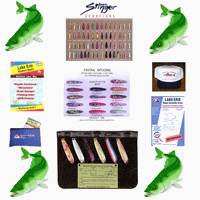|
Hard Water 'Eye Behavior
by Chris Wallace Every day you hear about someone and their
thoughts on the fishing that day.
 Solving
the puzzle on ice is being able to consistently pick the right stage
every time out on the ice. So letís go over the basics with walleye set
ups for dealing with aggressive, neutral and negative stages for
walleyes Solving
the puzzle on ice is being able to consistently pick the right stage
every time out on the ice. So letís go over the basics with walleye set
ups for dealing with aggressive, neutral and negative stages for
walleyes
How often have you heard the sayings "Those walleyes were in such a
negative mood today, I couldnít believe it" My favorite is, "I think I
could have thrown a bowling pin down there and caught fish on it." Well
both situations are true but last time I checked we canít talk to the
fish and find out what mood they are in.
My Aggressive combo consists of a Salmo Chubby darter, larger size
Jigging Rapalas or Nils Master, or a larger size buckshot spoon. I work
this with aggressive lifts and falls and I am trying to keep this moving
the whole time, this works great when the fish are aggressive, when your
are looking to sort through smaller fish and trying to cover a lot of
water quickly hole hoping, the beauty of this set up is that it helps
that you donít have to bring minnows with you, these baits are worked
without them.
Fish that are taking these baits are on the prowl; whether it be
cruising shallow weed lines or a deep mud flat, they are active in their
search for their next meal. Many times you can find this situation right
before a weather change, or after a few days of stable weather.
This puts us in Scenario 1:
Your out on a nice weed line that drops off to deep water, early ice as
the sun is starting to tickle the tops of the trees. You're working over
a fish down there that you can get to come up and look at the spoon but
canít get it to commit, your attracting phase is working but for some
reason the triggering phase of it is not finishing the deal. Reel up and
replace with a rod from your neutral set up.
My neutral set up is 1/8 oz, 1/16 oz buckshot spoons, large size willow
spoons, and this year the new Mega Glow demon spoons will also have a
spot here, the list goes on but go with your confidence bait.
Youíre looking for something not nearly as big and flashy. I donít work
this set up nearly as much as the aggressive ones, smaller lifts not
more then a foot or eighteen inches, with longer pauses in between. Try
to remember that your downsizing everything here, size, flash,
vibration, sound, so your jigging action should be doing the same thing,
downsizing. Another trick I like to do is pound it into the bottom every
once and a while and then pop it back up. 70% of my time fishing
walleyes will consist of this set up.
This is a great rod to run after marking fish but not getting them to
commit, more often than not, the vast majority of walleyes you catch
will be in this stage. Your aggressive fish are going to whack this bait
your average walleye will take this bait and you can even coax some of
the negative fish to take it. Chances are you will be spending a lot of
time in this area as well.
Scenario 2:
Your trip you have had planned to Mille lacs for the last week is here,
fishing had been great but yesterday a cold front came through,
temperatures dropped, snow came and the wind is whipping from the
northwest. You have your spot set up, when you lowered your Nils Master
down to the bottom the fish that was once holding tight on the bottom is
gone, so the aggressive stage is definitely out. Next, you lower down
your buckshot spoon and the fish comes back, but you canít get a rise
out of it, its sitting tight on the bottom. Reel up and try your third
round!
A Negative rod is something you want to grab first after a cold front or
big weather change. I also go to this after I have covered a mud flat
and am keying in on a few spots such as corners, jogs, inside turns, a
hole in the middle, anything that is small and different. Mega Glow
demons, fat boys, oddball jigs tipped with smaller shiners and you can
choose to use a split shot 6 to 8 inches above to anchor that minnow in
place, but I prefer to use the demons and fat boys simply because they
are big enough to anchor the minnow right there. The jigging is just
there to attract the fish and keep the minnow active, once they come in,
that minnow will do the rest of the work for me, very similar to a dead
stick set up.
Sometimes I am getting the fish to come in based on what I am reading
with my MarCum LX-5, I will open the bail and let the minnow fall to the
bottom, now its sitting there on bottom kicking silt and sand up, even a
lazy walleye will simply inhale it off the bottom and not think twice
about it.
Dead sticking is my second rod; all I am doing here is setting up an
anchored minnow on a glow Gamakatsu hook 6 inches to a foot off the
bottom, usually under an ice buster bobber. I do nothing to this rig,
about every 15 minutes I will re-check the minnow and re-glow. Thatís
the beauty of this rig, you set it up and thatís all you need to do.
Many times this is a great rod to have next to an active jigging rod,
the commotion that spoon makes with flash and vibration and the silt
from the bottom youíre stirring up will get the walleyes to come in and
investigate. If you can get them to come in, you have won half the
battle by getting their attention, at about this time the shiner or
fathead is getting really nervous, all the minnow is doing now is
driving nails into his coffin that vibration is picked up by the walleye
and he canít handle it.
Understanding the way a walleye reacts to your presentation is the
biggest part in refining your approach for that trip. Everything takes
time and being able to get it down precisely will make the most of your
trip. Practice selective harvest, Catch, Photo and Release, and always
remember to take a kid fishing.
Chris Wallace
LSF ProStaff
www.chriswallaceoutdoors |





 Solving
the puzzle on ice is being able to consistently pick the right stage
every time out on the ice. So letís go over the basics with walleye set
ups for dealing with aggressive, neutral and negative stages for
walleyes
Solving
the puzzle on ice is being able to consistently pick the right stage
every time out on the ice. So letís go over the basics with walleye set
ups for dealing with aggressive, neutral and negative stages for
walleyes